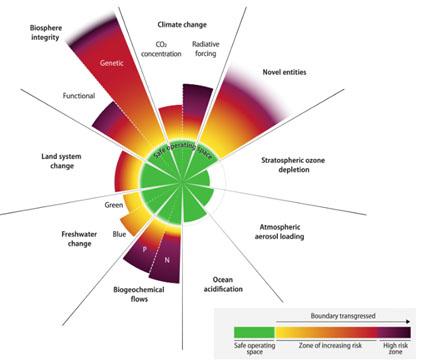05th novembre 2024, by SPIN
Science is clearly showing through data and evidence the urgency of implementing actions to mitigate the environmental, social and economic impacts of the TCLF industries. These developments are crucial to understand and define clear corporate strategies and policies for the future of the industries.
In recent years, the TCLF industry has experienced rapid growth. However, this expansion has come at a significant environmental cost, positioning it as a big contributor to global nature loss. The industries rely heavily on natural resources to produce their finished goods, thus contributing at various levels to deforestation, land degradation, ecosystem conversion, depletion and pollution of water resources (The Fashion Pact, 2023). For instance, producing a single t-shirt requires approximately 2,700 liters of water (European Parliament, 2020). And when this figure is scaled to the total number of t-shirts produced globally each year, the impact becomes staggering. According to Global Fashion Agenda, the fashion industry consumes more than 79 trillion liters of water annually, with most of this usage occurring during the raw material production phase (Global Fashion Agenda, 2024).
The primary issue underlying this trajectory is the pace of consumption, which is closely tied to global population growth and the rise of synthetic fibres. Over the past two centuries, the world’s population has undergone unprecedented expansion. In 1800, there were approximately one billion people; today, that number exceeds eight billion (Our World in Data, 2024). This population surge has intensified the pressure that anthropogenic activities place on natural resources but also the reduction of the uptake of naturally occurring by-products, contributing dramatically to greenhouse gas emissions increase, fuelling climate change and other environmental pressures. As a result, the balance between human consumption and the Earth's biocapacity has been severely disrupted, with the planet being increasingly unable to meet the demands of humanity’s resource consumption. We are now surpassing the Earth’s capacity to regenerate resources at an alarming rate.
This overshoot is clearly reflected in the state of the Earth's Planetary Boundaries. Of the nine Boundaries that define the safe operating space for humanity, six have already been transgressed, with the most critical areas being "climate change," "biosphere integrity," and "biogeochemical flows." A seventh boundary, "ocean acidification," is approaching its threshold for transgression, particularly in sensitive regions such as the Antarctic and Arctic Oceans. While the remaining two Boundaries—"stratospheric ozone depletion" and "atmospheric aerosol loading"—have shown some stability and minor improvement, the situation remains dire (Richardson K. et al., 2023).

Fig. 1. Current status of control variables for all nine planetary boundaries
Although "climate change" is perhaps the most widely recognized planetary boundary, the concept of the planetary boundaries is that carbon is not the only issue to be addressed. For instance, the degradation of "biosphere integrity" represents a severe and immediate crisis. The loss of biodiversity not only poses environmental risks but also has significant economic implications. It is estimated that biodiversity loss results in approximately $5 billion in annual economic losses, equivalent to around 6% of the global GDP (BCG - Quantis, 2024).
To help companies in aligning with this goal, one of the initiatives that can be mentioned is the Science Based Targets Initiative (SBTi) - a corporate climate action organization that enables companies and financial institutions worldwide to play their part in combating the climate crisis. SBTi has developed Science-Based Targets aligned with the 1.5°C threshold. Science-Based Targets enable companies to establish emissions reduction goals grounded in scientific evidence, applying a top-down approach that specifies the emissions reductions needed to meet the Paris Agreement’s targets. This provides a clear, evidence-driven path for companies to reduce greenhouse gas (GHG) emissions and contribute to limiting global warming to 1.5°C above pre-industrial levels (Science Based Targets, 2024).
The urgency to shift toward a more sustainable trajectory has been acknowledged by the European Union. Such objective is part of the broader European Green Deal, a comprehensive strategy designed to guide the EU towards a green transition. Several key legislative initiatives within this framework are directly relevant for the TCLF industries:
1) The Ecodesign for Sustainable Product Regulation (ESPR), which aims to improve all the environmental sustainability aspects of products placed on the EU market;
2) The Corporate Sustainability Reporting Directive (CSRD), which modernizes and strengthens the rules concerning the social and environmental information that companies have to report;
3) The Corporate Sustainability Due Diligence Directive (CSDDD), which requires EU large companies to identify and address adverse human rights impacts and environmental impact in their whole supply chains;
4) The European Deforestation Regulation (EUDR), which requires EU stakeholders to verify that the trade of certain products, such as leather, cocoa and cattle, are not associated with deforestation risks;
5) The Green Claim Directive Proposal, which aims at guaranteeing that consumers receive reliable and verifiable environmental information on products.
Addressing the TCLF industries’ environmental and social impact requires a comprehensive and science-driven approach to sustainability. TCLF companies must collaborate closely with their suppliers to embed sustainability throughout their operations, thus creating a ripple effect that can amplify positive change across the entire value chain. A collective commitment across these sectors is crucial to drive the systemic change needed for a resilient and sustainable future (McKinsey, 2024).
by SPIN
Publication date: 2024-11-05